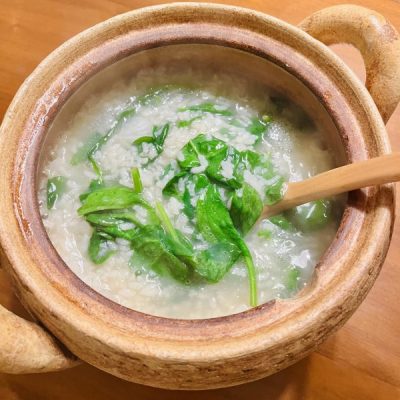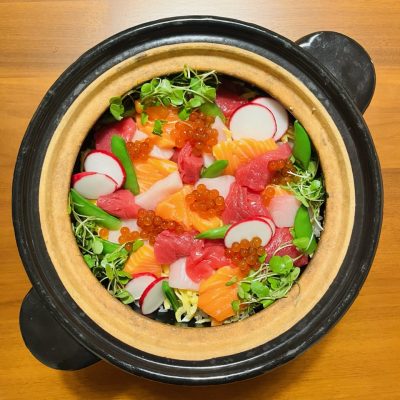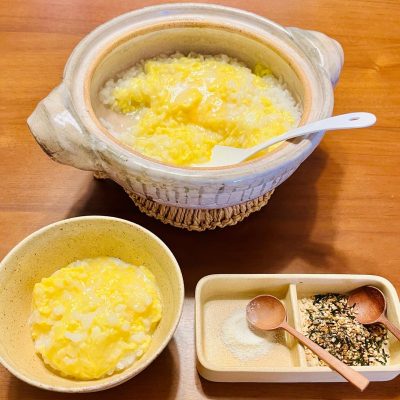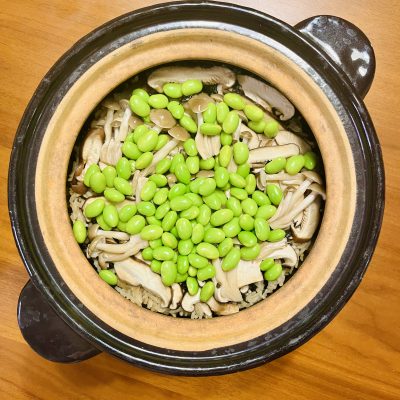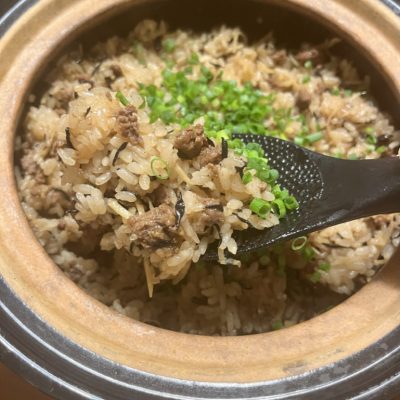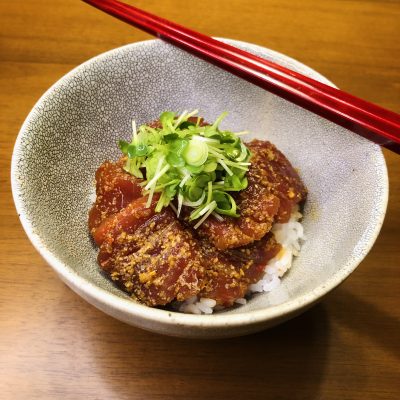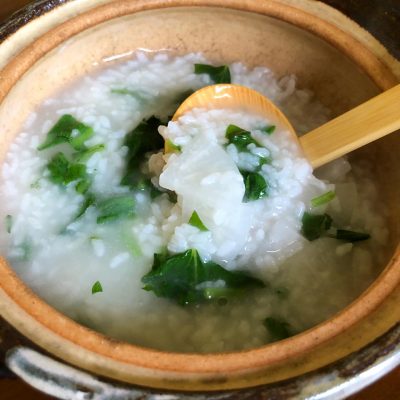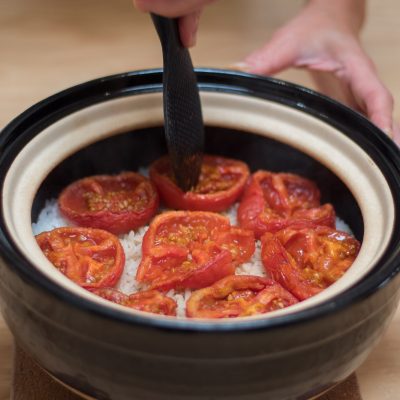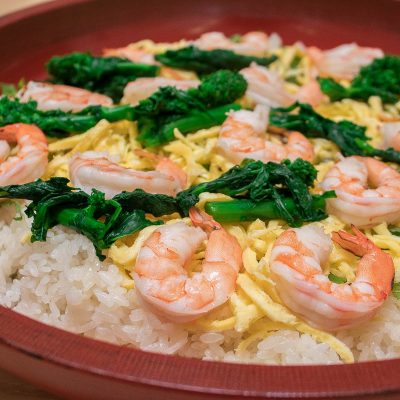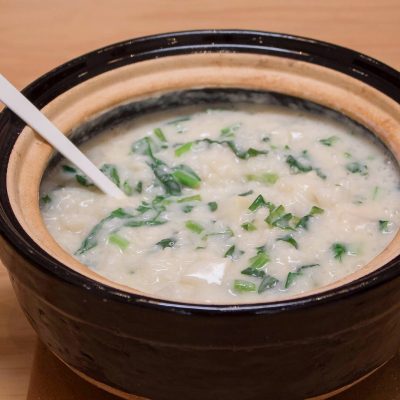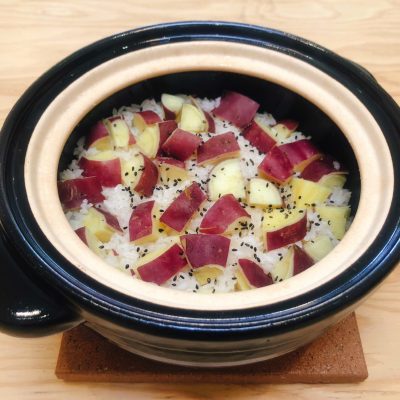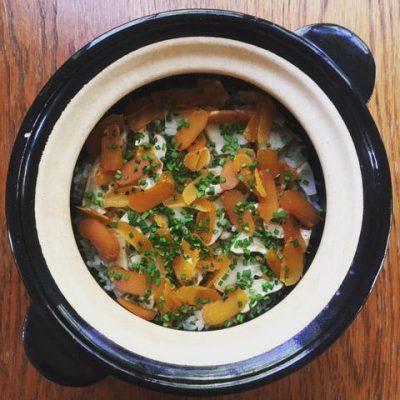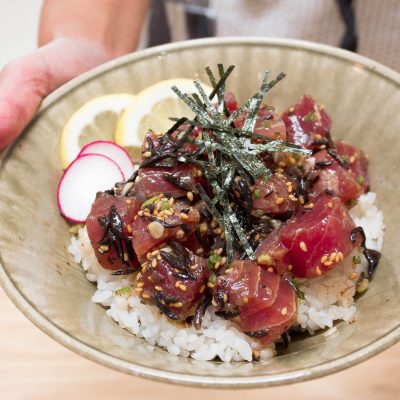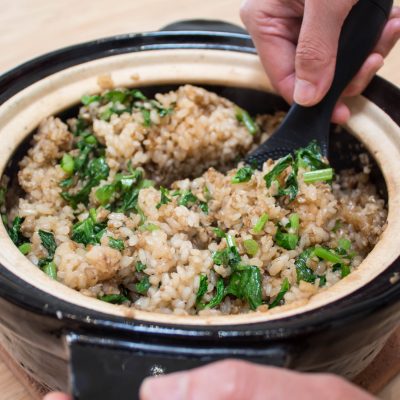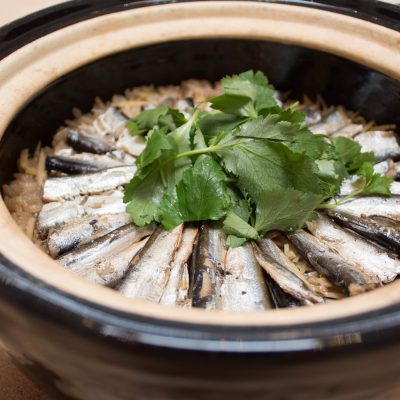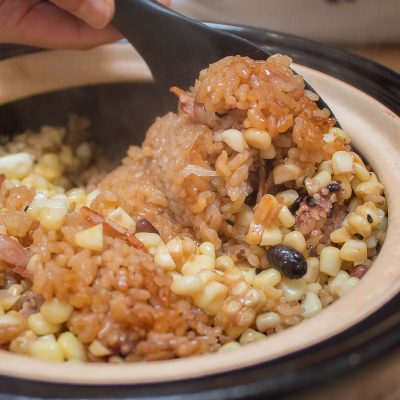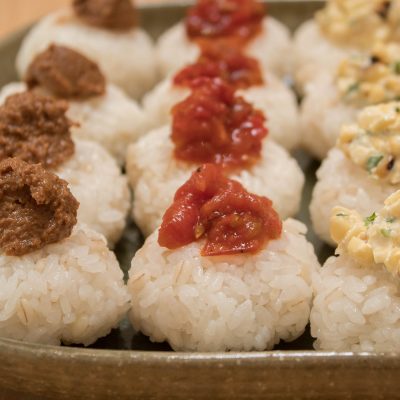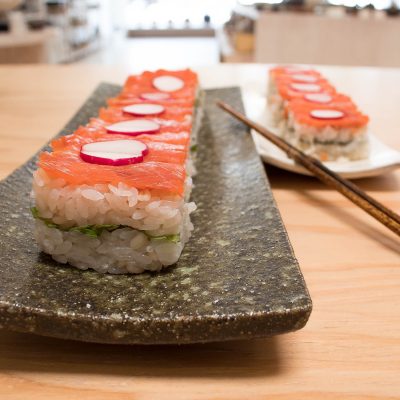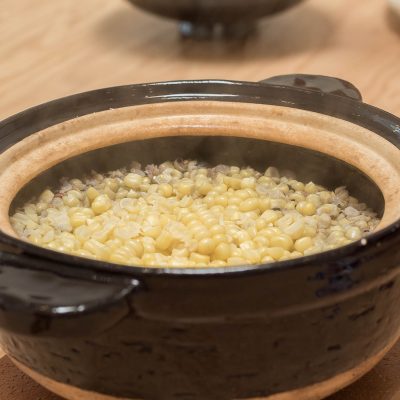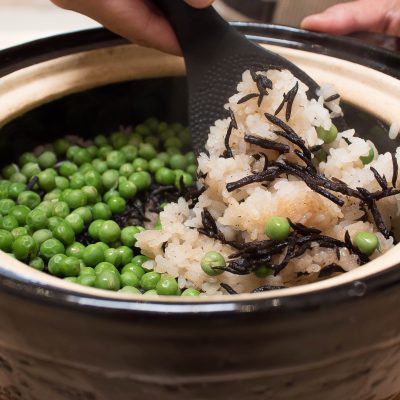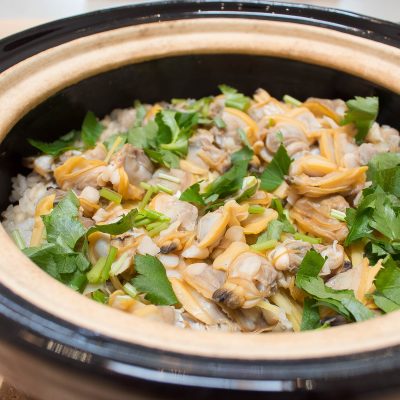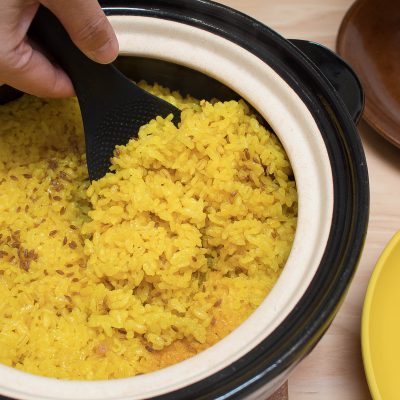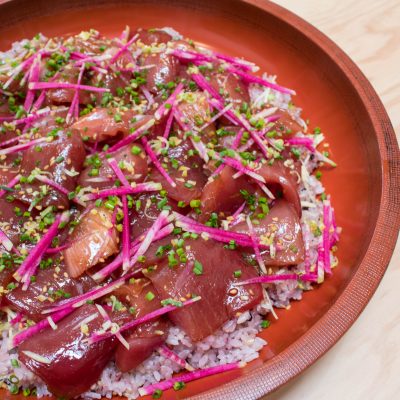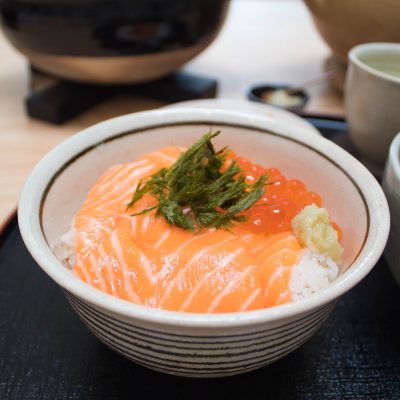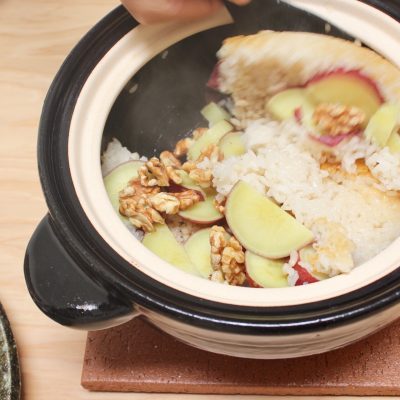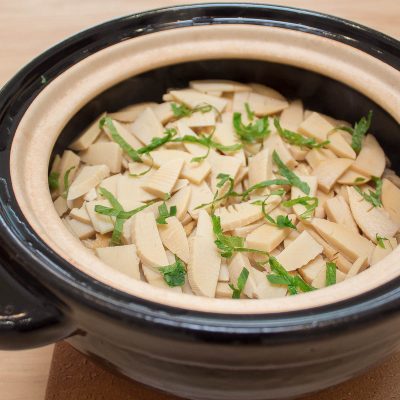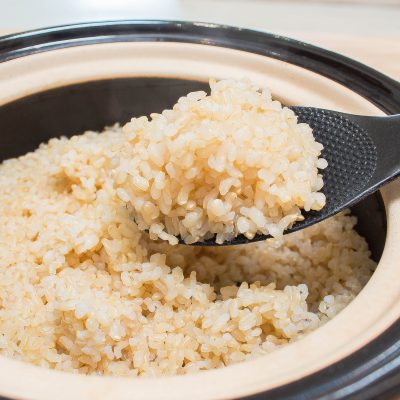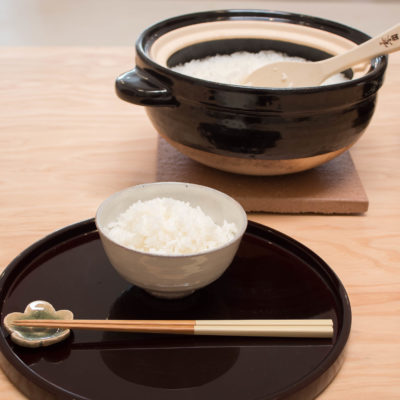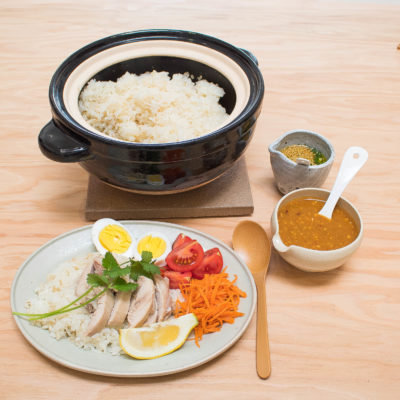My summer obsession of donabe corn rice has so many variations and this one is my new favorite! I never thought the combination of umeboshi (Japanese pickled plum) and corn make such great combination in flavors. I love making onigiri with this rice to take to picnic!
Tag Archives: Rice
English Peas & Hijiki Mochi Mugi Rice
I can’t get enough of fresh English peas in the spring time. Here’s a slightly different version (and I would say even easier version) of my original English Peas and Hijiki Rice recipe, and this is equally delicious! Instead of using dashi stock, I add a content of a Vegetable Dashi packet directly to the water. The result is really umami rich and aromatic rice. Mochi Mugi barley adds nice texture and flavor, too. If you can’t find shelled fresh English peas, you can use frozen kind by thawing them before adding to the donabe.
Spinach and Daikon Porridge
This is quick Spinach & Daikon Porridge I have been making often lately. It requires minimum prepping/ chopping. Instead of starting with cold water and rice, I boil vegetable dashi and add rice to cook. The texture of the rice turns smoother this way, and the flavor is amazing. The combination of daikon and spinach makes the dish taste even better.
Seafood Chirashi Sushi
My donabe Seafood Chirashi Sushi (Seafood scattered over sushi rice) is really simple to make, and it always comes out so festive and delicious! Double-lid Donabe Rice Cooker, Kamado-san can make the perfectly shiny sushi rice, and you just need to decorate the rice with your choice of sashimi quality seafood and vegetables. That’s it. I normally buy extra amount of seafood so I can serve any remainder on the side.
For those who want to know where I buy my seafood from, I love Kai Gourmet! They have the sustainably sourced premium sashimi quality seafood and deliver to your door, anywhere in the US. I can order by midnight and get my order overnight. I have been a huge fan of Kai Gourmet for many years.
This time, I partnered with Kai Gourmet and have a promo code for you. Visit their website and enter the below code to receive 10% discount for your order (full priced items only). Hope you will try their seafood!
Website: https://kaigourmet.com/
Promo Code: ToiroKai10
Beef Rice
Juicy donabe Beef Rice for your stamina. I used a block of American Wagyu hanger steak and thinly sliced by hand. By marinating the beef for a short time with sake, soy sauce and black sugar, the meat comes out so tender like you braised it! I also used some smoked soy sauce to complement the bold flavor but you can use only regular soy sauce, too. Donabe makes this dish so complete in flavor and texture, and it was just so delicious that I ate almost half of the pot. Happy Donabe Life!
Corn & Hijiki Rice with Olive Oil
This donabe dish is a variation of my other corn rice recipes and has been a big hit! This is 100% vegan and its flavor is really rich with corn, and fresh and aromatic with the addition of the extra virgin olive oil and mixed herbs. This dish makes a great one plate meal and tastes great at a warm or room temperature. Happy Donabe Life!
Sea Bream Rice
One of my favorite dishes to eat during the spring is Tai Meshi (Sea Bream Rice), made in a donabe. I cook the rice with a whole Tai (sea bream), so it’s not only very flavorful but the dish is perfect for festivity. I usually cook this dish with my double-lid donabe rice cooker, Kamdo-san, but since the fish I got this time was much bigger than my 3 rice-cup size Kamado-san, I decided to make it in my large-size donabe (I used my donabe steamer, Mushi Nabe, without the steam grate). By bending its tail, I could barely fit it in my donabe! To garnish, kinome (sansho leaves) are typically used in Japan. But since it’s hard to find kinome here in LA, I used dill and it paired with the rice beautifully.
Egg Porridge
This donabe egg porridge is an extremely simple dish and made with just three ingredients – water, rice, and egg. This is one of my favorite dishes since I was a child. When I got sick, this is what my mom used to make for me, and I always looked forward to a small donabe brought to my bed and mom serving it for me! Egg porridge is so gentle on stomach and easy to digest. It is a perfect dish to enjoy a day after a big holiday meal. I like to serve it with a couple of condiments- Yuzu Salt and nori furikake called Nori Senbyo. Or with just a little sprinkle of Moshio sea salt is lovely, too.
Mixed Mushroom and Hijiki Rice
This is one of my regular donabe rice dishes. Mixed mushrooms, hijiki, and edamame – I love the combination of these flavors when they are mixed with rice. I use kombu and shiitake mushroom dashi, so this is a vegan dish but feel free to use your choice of dashi, stock or even just water. The dish come out aromatic and so satisfying every time.
Ginger Hijiki Beef Rice
This dish has a nice bold flavor of soy-flavored beef and ginger. Hijiki adds another layer of flavor and balance. This dish is always a hit at dinner parties. You can use a generous amount of ginger and won’t be disappointed. The oyster sauce makes the dish extra complex, but if you don’t have it, you can simply substitute it with extra 1/2 tablespoon soy sauce. I enjoy serving this dish with simple stir-fry vegetables (such as bok choy or broccoli).
Spicy Soy-Marinated Tuna Rice Bowl
When I get really fresh fish, I enjoy eating it straight as sashimi, or I also enjoy creating a quick one-bowl meal by topping it over rice. It never goes wrong. You can make it with sushi rice or just plain rice. I also like to quickly marinade the sashimi in soy-based sauce to top over the rice. It’s called Zuke-Don. Zuke means “marinade”, and Don is donburi rice bowl. Here’s my really tasty Spicy Zuke-Don with fresh tuna.
Daikon Porridge
Slow-Roasted Tomato Rice
Tomato is one of my favorite summer vegetables (or technically it’s a fruit), and make a lot of slow-roasted tomatoes for various recipes. One of them is Cold Somen Noodles with Slow-Roasted Tomato, and here is another one! Once you have the slow-roasted tomatoes ready, all you need to do is basically make plain rice with Kamado-san, then top the rice with the slow-roasted tomatoes. You can gently break the tomatoes to mix with the rice. The umami of the tomatoes are so condensed after the long slow roasting, the rice itself doesn’t need any other flavoring or seasoning.
I love it with chopped Japanese herbs and chunky la-yu (recipe is found in my DONABE Cookbook), but commercial la-yu (spicy chili oil) or any hot sauce can work, too.
Tuna Hot Pot
One day, a very good customer of ours stopped by at our shop to give us a block of fresh tuna he just caught from fishing in the Pacific Ocean. How sweet of him! It was super fresh sashimi quality, so we tried some as sashimi with different kinds of soy sauces we have, then for the remaining, I decided to make a donabe hot pot with it. Tuna hot pot in donabe is a popular dish in Japan, and it’s typically made as a combination with negi (Japanese green onion). It’s called Negi-Ma Nabe. The name is short for Negi (green onion) Maguro (tuna) Nabe (hot pot).
This dish is very simple, and all you need is good quality dashi, tuna (obviously!), green onion (for the name’s sake) and any other ingredients you like to add. I like it with my ponzu.
For the shime (finishing course), I like making quick ojiya (porridge) with freshly-cooked donabe rice.
Shrimp and Rapini Chirashi Sushi
Chirashi Sushi (sushi rice with scattered toppings) is a great dish for celebration, and I make this colorful dish for Japanese New Year or other party occasions. The most unique part about this dish is that the rice is seasoned with daidai citrus juice, instead of rice vinegar to make the sushi rice. Daidai is a Japanese citrus that is similar to orange but with brighter aroma and flavor. When the rice is seasoned with daidai juice, the beautiful aroma of daidai spreads around it and it’s so appetizing.
Egg crepes, rapini and shrimp create beautiful colorful visual and and the flavors are also wonderful together, too. Feel free to substitute them with other toppings of your choice for fun.
Soymilk Porridge with Turnips
I eat a lot of porridge especially in the winter time, as the dish is not only so gentle to your stomach, but is also a great way to keep your body warm. In Japanese tradition, on January 7, we eat Nanakusa-gayu (7-herb rice porridge), and it’s a custom to to bring health and longevity. It also has a meaning to clean your body with this simple porridge after consecutive days of feast during the New Year holidays.
Outside of Japan, including Los Angeles where I live, it’s not easy to source all the 7 kinds of Japanese herbs locally, so I actually enjoy making my own version with just kabu (Japanese turnips; its’ leaves are one of 7 herbs in Nanakusa-gayu) and use pure soymilk, in addition to kombu infused water, to cook the rice. It’s rich, creamy, really flavorful, and still light in your stomach.
It’s totally fine to cook it only with water (for more plain version), or use your choice of dashi such as kombu and bonito dashi for slightly deeper flavor. And, you can enjoy with your choice of condiments.
Pressed Sea Bream Sushi
Tai (sea bream or also called tai snapper) is one of my favorite kinds of fish to eat both raw or cooked, and this fish is a symbol of celebration in Japanese culture. So, I love making this dish especially when I want to celebrate. The beautiful pink color of the fresh tai brings out the happy feelings and stimulates appetite. And, as long as you get the high quality sashimi-grade fish and rice cooked in Kamado-san, this dish is basically error-proof and always tastes wonderful. The fish is sliced not too thin, and I like to use a generous amount of it, so I can really enjoy the taste of it. The shiso leaves between the layers of the sushi rice gives nice aromatic quality to the dish, but if you can’t find them, it can be omitted.
Japanese Sweet Potato Rice
This is one of my favorite fall-to-winter rice dishes since I was a child. This is such a simple dish, as the main ingredients are just the rice and satsuma-imo (Japanese sweet potato), and they are seasoned very lightly only with salt. The natural sweetness of the satsuma-imo is fully brought out after cooked with the rice, and the texture is nicely soft to work great with the shiny chewy rice. I also love making onigiri (rice balls) with this dish. They taste great hot or room temperature. If you want to add more flavor, you can cook the rice with dashi or even consommé works nicely, too.
Bottarga and Matsutake Rice
When I’m lucky enough to have these special ingredients at the same time, I love making this dish. The earthy perfumy aroma of matsutake mushroom is so elegant and there is nothing equivalent to it. The umami-packed and slightly chewy character of karasumi (cured mullet roe, a Japanese delicacy, and it’s also a famous Italian ingredient, called bottarga in Italian.) You can substitute matsutake mushroom with a different kind of mushroom such as shimeji (although the aroma is very different, it’s still tasty) when matsutake is out of season. For karasumi, instead of slicing it, you can grate it to mix in the rice, too.
The dish shown in this photo is made in 1 rice-cup size Kamado-san.
Tuna Poke Rice Bowl
As I have been to Hawaii almost 50 times since I was a teenager and I’ve been loving their local seafood dishes, I am a self-claimed poke expert (haha). My favorite style of poke is quite simple…it’s all about high quality tuna, soy sauce, sesame oil, and wasabi. When I serve it as an appetizer, I encourage my guests to enjoy on its own or make a wrap with lettuce and nori. To make a meal out of poke, I make this poke don (poke rice bowl). With the sushi rice made in double-lid donabe rice cooker, Kamado-san, this simple dish becomes such a decadent sushi dish you can create at home.
Earthy Burdock Root Rice
Gobo (burdock) has a natural sweet earthy aroma, and I love the combination of minced gobo with rice for its hearty taste. Daikon leaves add a layer of earthy flavors and texture. If you can’t find daikon leaves, kale can work nicely, too. With this rice dish and a bowl of miso soup, it will make a happy donabe meal for me.
Mixed Mushroom Rice
I love the earthy treat. I like to use a few kinds of mushrooms such as shiitake, king oyster, and shimeji. You can try with your choice of mushrooms. By adding sweet rice, the dish becomes nice and slightly chewy texture, but you can also make it only with short grain rice and it will taste very nice, too. For seasoning, I love white tamari, for its mellow and slightly sweet aroma, but you can substitute with usukuchi shoyu or regular soy sauce, too.
Oil Sardine Rice
Canned oil sardines are great items to store in your pantry. It’s ready to use and rich in umami and nutrients. This sardine rice is so easy to make, as all you have to do is basically remove the sardines from the can and top on the rice with a few other ingredients to cook. Make sure to use a little amount of the oil from the can, as it’s infused with all the rich flavors of the sardines. I also highly recommend you sprinkle some Sansho Powder when serving, as the bright citrusy kick of the sansho with the rich sardine flavors work so well together. Oh, a little squeeze of fresh lemon over the rice is also nice, too.
I also like to cook this dish with the addition of Mochi Mugi barley. If you would like to cook with the Mochi Mugi, add a packet of Mochi Mugi to the rice and extra 1/2 cup (120 ml) of dashi and a pinch of salt in Step 1 of the recipe.
Tomato Ginger Rice
Half-cut tomatoes are cooked together with rice in the donabe and becomes an extremely luscious dish. Tomatoes break so easily with a rice paddle and once you gently mix the contents, the beautiful red color coats the rice and imparts the sweet aroma of tomatoes and ginger. While this dish is completely vegan, even my meat-loving friends go crazy over it. (And, they fight over Naosco, the Yuzu-Kosho flavored hot sauce I make as a condiment for this dish.)
I love making this dish while the tomatoes are in season during summer. But, tomatoes don’t have to be very ripe to make this dish, so you can enjoy making this dish any time of the year.
Smoky Shoyu-Flavored Corn & Bacon Rice
Here’s another version of my corn rice; this one has a big, bold flavor with the addition of rendered bacon, Smoked Soy Sauce, and butter. This is a great dish to serve at a summer party, too. When I made this dish at an outdoor BBQ dinner one day, everybody went crazy and it was gone so quickly! Corn is so sweet and savory at the same time, with its nice smokey and nutty flavor. Although this addition is highly recommended, if you would like to omit the 16 Multi Mixed Grains, you can reduce the amount of the dashi by a tablespoon or so.
Rice Balls with Three Kinds of Toppings (Summer Version)
At our 2018 Summer Festival at TOIRO, we made hundreds of onigiri (rice balls) with freshly made rice in our double-lid donabe rice cooker, Kamado-san, and served with these summer-theme toppings. We were so happy that many of our guests kept coming back to try more. The Walnut Miso includes Fig Vinegar so it has a refreshing and soft acidity. The Slow-Roasted Tomato is rich in umami and the Smoked Soy Sauce adds an extra layer of complexity. The Roasted Corn and Yuzu-Kosho Mayo has a beautiful, sweet corn flavor with an aromatic heat from the Yuzu-Kosho. These toppings are also great to serve with cold tofu or grilled meat. We hope you will try all three kinds. The amounts of these toppings in this recipe are more than enough to make the suggested servings, so you can keep any leftover for another use.
Pressed Smoked Salmon Sushi
Oshi-Zushi (pressed sushi) is always fun to make and is also tasty, especially when the rice is cooked in a Kamado-san. You can see in the photo how each grain retains its shape and is shiny after the sushi is pressed. The traditional wood sushi mold makes the process so easy and brings beautiful results. Here’s my quick oshi-zushi recipe, which can be made with something I normally stock in my fridge…smoked salmon, radish, and shiso leaves. If you don’t have access to shiso leaves, you can substitute with arugula or simply omit it. If you want to add Mochi Mugi barley to the rice, simply add a packet of Mochi Mugi to the rice and increase the water by 1/2 cup (120 ml) and cook together.
Corn Rice
Corn rice is one of my favorite summer dishes to make. It’s simple and full of summer flavors. I like to cook with my cold-infused Kombu and Shiitake Mushroom Dashi, so I just let the dashi infuse half-day to overnight in the fridge and it’s ready to use. This dish is completely vegan, but you can cook with your choice of other stock (kombu & bonito dashi, chicken stock, etc.), too. For this recipe, I also added a packet of 16 Multi Mixed Grains (it’s so good), but if you would like to make it without it, you can reduce the amount of the dashi by a tablespoon or so. To add some kick to the dish, I like adding the Kanzuri Yuzu Sauce to the dish. You can top the rice with a small amount of the sauce or mix it in to the rice to enjoy. It’s quite addictive.
English Peas and Hijiki Rice
During the spring time when the English peas are in season, I make this dish often. The shelled fresh peas are added to the donabe after turning off the heat and cooked only with the carryover heat. When the dish is ready, the peas are nicely cooked through while they bring the beautiful fresh sweet aroma and retain the beautiful color and texture. This dish is also great for onigiri (rice balls) to take to picnic, as it tastes delicious at a room temperature, too.
Clam Rice
This is a popular Japanese dish and we love it especially in the spring time when the clams are in the top season. Plump sake-steamed clams are folded in to the donabe rice, cooked with the combination of clam juice (from steaming) and dashi. My version uses extra amount (almost double or more) of clams compared to normal clam rice recipes, because I like to really enjoy the meaty clams in the rice! But, you can also make the dish with less amount of clams, and the dish would still taste delicious.
I also like to cook this dish with the addition of Mochi Mugi barley. If you would like to cook with the Mochi Mugi, add a packet of Mochi Mugi to the rice and extra 1/2 cup (120 ml) of dashi and a pinch of salt in Step 3 of the recipe.
Turmeric Rice with Mochi Mugi Barley
With the bright color and aromas, this dish can stimulate your appetite so much. Once you sauté the spices with rice and Mochi Mugi barley, just add the stock (or water) and let the Kamado-san do the work for you. The entire process is done over medium-heat. It’s so flavorful and I love the bouncy texture of the barley in the dish, too. This dish is especially great with Pork Keema Curry, and when I make this combination, I always end up having second (and sometimes even third) bowl. If you wish to make it without the Mochi Mugi, reduce the stock (or water) amount by 1/2 cup (120 ml), then reduce each spice’s amount a little bit.
Chirashi Sushi with Soy-Marinated Tuna
This dish is very easy to make and always a crowd pleaser. Once you get a block of very fresh tuna, all you have to do is to make sushi rice, slice and marinade tuna, get other small components ready and just assemble. The marinating time of tuna should be just up to 15 – 20 minutes. If it’s marinated too long, it will start to “cook” the tuna and the color could get a bit too dark. I like to make the sushi rice by adding 16 Multi Mixed Grains for more complex flavor, texture, and beautiful color in the sushi rice, but you can make it without, too. Whenever I make this dish for friends, it disappears in a matter of moments!
Salmon and Ikura Sushi Rice Bowl
With Kamado-san, you can make really tasty sushi rice with perfectly chewy texture. I like making sushi rice bowl and top with whatever the freshest sashimi grade seafood I find at a local market. Salmon and ikura (salmon roe) combination makes beautiful bright visual and always tastes good together.
Mochi Mugi Barley & Rice
Mochi Mugi is a type of barley and it is considered to be a “super food”, as it contains much higher amount of fiber than brown rice or regular kinds of barley. For me, Mochi Mugi simply tastes so good and I really enjoy its nice bouncy texture. By adding a small amount of Mochi Mugi to your rice, your rice becomes not only more nutritious but it adds another nice dimension in the flavor. For each packet of Mochi Mugi, 1/2 cup (120 ml) water is needed to cook.
Sweet Potato & Walnut Rice
Satsuma-imo (Japanese sweet potato) and roasted walnuts bring rich earth and sweet flavors to this dish.
Bamboo Shoot Rice
Spring is the high season for freshly foraged bamboo shoots and they taste really wonderful. They are crisp tender and full of sweet spring flavors. In Japan, people enjoy so many different kinds of bamboo dishes while the fresh shoots are in season. Bamboo shoot rice used to be my favorite bamboo dish my mom made when I was a child. This dish also tastes great at room temperature or even cold. If fresh bamboo shoots are not available, pre-cooked bamboo shoot can be found at Japanese grocery stores and they are sold all year round.
Plain Brown Rice
For whole grain (unpolished) brown rice
Plain White Rice
Basic white rice cooking method with Kamado-san
Nao Man Gai (Chicken Over Rice)
This dish is inspired by kao man ghai, a very popular Thai-style chicken rice dish, (or the Singapore-style is known as Hainanese chicken rice), and I made it in my donabe Japanese version with mostly Japanese ingredients. So, I call it Nao Man Gai! The rice is cooked with rich Japanese chicken stock with chicken on top, so the rice tastes really special even on its own. The chicken is sliced and served on top of the rice along with two kinds of special sauces. Don’t forget to make non-boiled “boiled eggs” by placing eggs on the inner lid of Kamado-san when cooking the rice. The eggs are ready when the rice is ready, and they taste so good with the dish!



